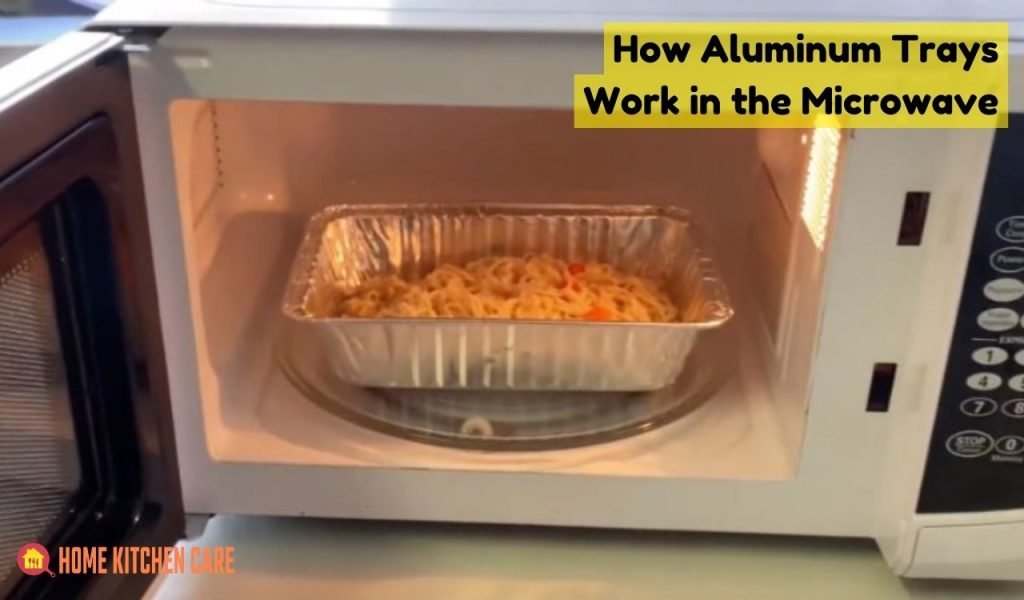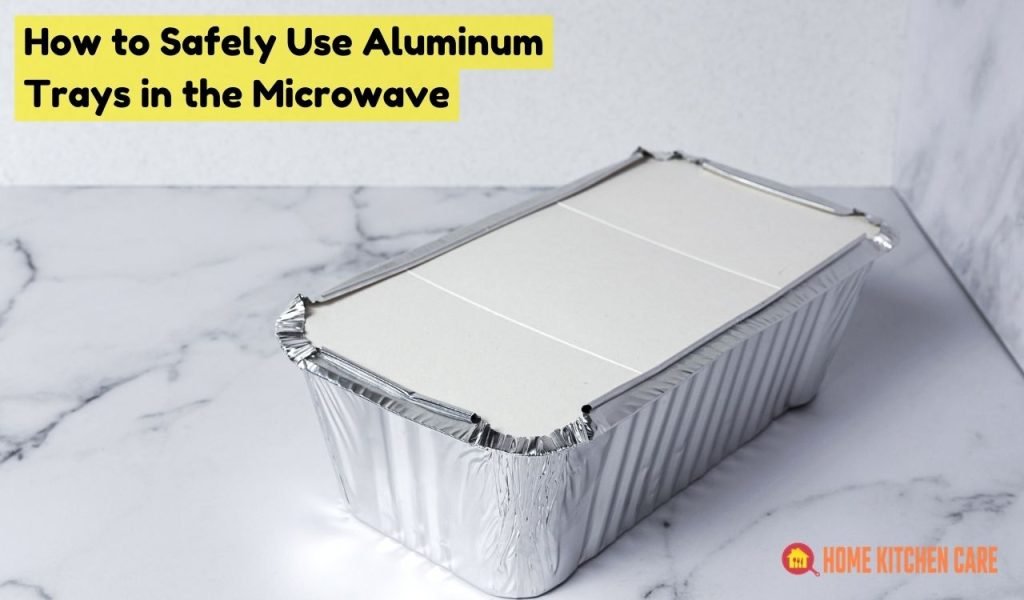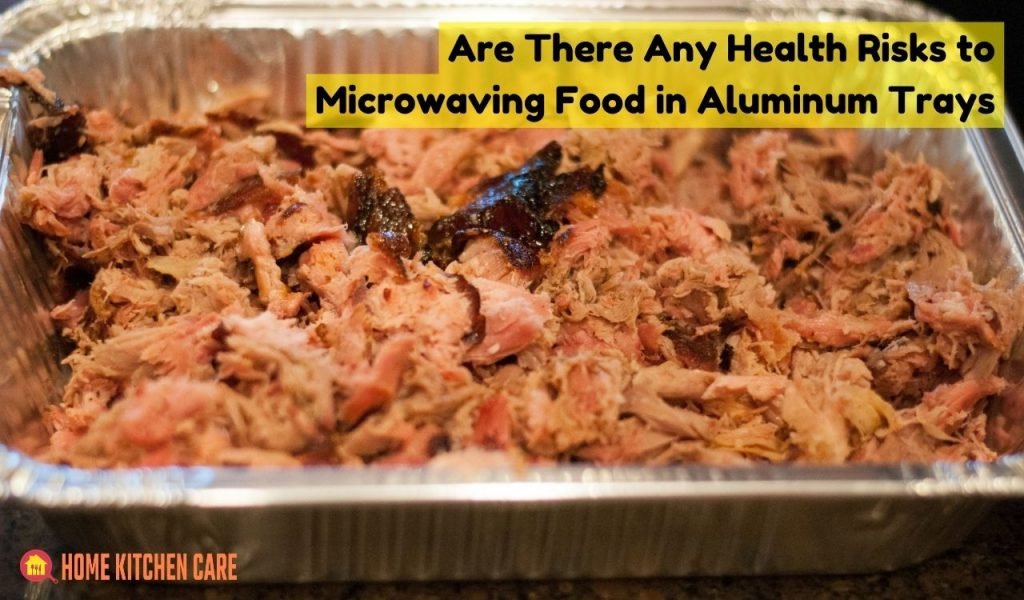Physical Address
304 North Cardinal St.
Dorchester Center, MA 02124
Physical Address
304 North Cardinal St.
Dorchester Center, MA 02124

Are you wondering about the safety and usability of an aluminum tray in microwave? Well, we’ve got you covered! In this guide, we’ll explore the fascinating world of using aluminum trays in the microwave. From addressing potential risks to providing essential tips, we’ll help you navigate the do’s and don’ts.
So, if you’re ready to uncover the secrets of microwaving with aluminum trays, let’s dive right in and discover how you can make the most of this convenient cookware. Get ready to revolutionize your microwave cooking experience with aluminum trays!
Main Summary: Aluminum Tray in Microwave.
Using aluminum trays in microwaves can lead to potential hazards. The metal may cause sparks and damage the appliance, posing safety risks. Opt for microwave-safe alternatives like glass or ceramic dishes for worry-free heating. Stay safe and avoid using aluminum trays in microwaves.
Using an aluminum tray in the microwave raises concerns about its suitability and potential risks. Aluminum, being highly conductive, can reflect electromagnetic waves, which are the basis for cooking in microwaves. This can lead to uneven heating and hotspots in the food. Additionally, the reflected waves may bounce back to the microwave’s power source, the magnetron, causing damage to the appliance over time.
Moreover, using aluminum trays in the microwave carries the risk of sparks and fire hazards. Metals in the microwave can cause arcing and generate electric charges, especially if the tray has sharp edges or points. These sparks can damage the tray itself and even ignite flammable materials, posing a significant safety concern in the kitchen.
To ensure safe and efficient microwave cooking, it is generally not recommended to use an aluminum tray. Instead, opt for microwave-safe containers made of glass, ceramic, or microwave-safe plastic. These materials are designed to withstand the microwave’s heat and electromagnetic waves without posing risks to your food or microwave appliance.
By prioritizing safety and using appropriate cookware, you can enjoy worry-free cooking in the microwave while minimizing potential hazards associated with using improper containers. Remember, the well-being of yourself and your loved ones should always be the top priority in the kitchen.

Ever wondered how aluminum trays behave when placed in the microwave? The conductive properties of aluminum make it a material of concern. Does it shield the food from the microwaves, causing uneven heating? Can it damage the microwave itself? In this article, we will delve into the workings of aluminum trays in the microwave, shedding light on their behavior and potential effects. Join us as we demystify the interaction between aluminum trays and microwaves.
Microwaves cook food by emitting electromagnetic waves that excite water molecules, generating heat. This process is called dielectric heating. Now, when it comes to aluminum, it is a highly conductive material that can reflect these waves. This raises concerns about using aluminum trays in the microwave.
Due to its conductive properties, an aluminum tray acts as a shield, preventing the microwaves from directly penetrating the food. Instead, the waves bounce off the aluminum surface, potentially leading to uneven cooking and hotspots. Moreover, the shielded waves can reflect back to the magnetron, the microwave’s power source, which could damage the appliance.
Another crucial consideration is the risk of fire. Aluminum is a metal, and metals in the microwave can cause sparks and arcing. If there are sharp edges or points on the aluminum tray, they can generate electric charges and trigger these dangerous reactions. The sparks can damage the tray itself or even start a fire.
When it comes to microwaving an aluminum tray, there are concerns about what actually happens during the process. Does the aluminum reflect the microwaves, resulting in uneven heating? Can it cause sparks or even start a fire? In this article, we will explore the consequences of microwaving an aluminum tray, shedding light on the potential risks and effects on your food and microwave appliance. Let’s delve into this intriguing topic and uncover the truth behind microwaving aluminum trays.
When you microwave food in an aluminum tray, the reflected waves can create a “shielding effect.” This means that the food near the aluminum surface may not receive the same amount of heat as the rest of the dish. As a result, your food might end up partially cooked or have varying levels of doneness.
Using aluminum trays in the microwave can have consequences for both your food and the appliance itself. As mentioned earlier, the reflected waves may bounce back to the magnetron, the microwave’s power source. Over time, this can cause damage to the magnetron, leading to reduced performance or even complete malfunction.
Perhaps the most alarming risk of using aluminum trays in the microwave is the potential for sparks and fires. As the waves reflect off the tray’s surface, they can create electrical charges and cause arcing. This phenomenon can ignite flammable materials, including the tray itself, and pose a serious safety hazard in your kitchen.

Microwaving food in aluminum trays is a topic of concern for many individuals. Can these versatile trays be safely used in the microwave without any negative consequences? In this article, we will explore the proper and safe usage of aluminum trays in the microwave.
By following a few guidelines and taking necessary precautions, you can enjoy the convenience of using aluminum trays for microwave cooking while ensuring your safety and the quality of your food.
Not all aluminum trays are suitable for use in the microwave. To ensure safety, it is essential to choose aluminum trays that are specifically labeled as microwave-safe. These trays are designed to withstand the intense heat and electromagnetic waves produced by the microwave, reducing the risks associated with using improper cookware.
When selecting an aluminum tray for microwave use, it is crucial to avoid trays with sharp edges or pointed corners. These features can generate electric charges and trigger sparks or arcing in the microwave, which may lead to safety hazards and potential damage to the tray or the appliance itself.
To promote even heating and prevent potential issues, it is recommended to maintain a proper distance between the aluminum tray and the walls of the microwave. This allows for better circulation of microwaves and reduces the chances of hotspots or uneven cooking. Follow the manufacturer’s guidelines or refer to the tray’s instructions for the recommended distance.
When microwaving food in aluminum trays, it is advisable to use microwave-safe covers or wraps. These covers not only prevent food from splattering and making a mess but also help retain moisture and promote more efficient cooking. Ensure that the covers or wraps are specifically designed for microwave use to avoid any potential hazards.
Proper monitoring of cooking times is essential when using aluminum trays in the microwave. It is recommended to follow the recommended cooking times for the specific dish being prepared. Additionally, stirring the food at regular intervals promotes even heating and helps prevent hotspots. This practice ensures that your food is thoroughly cooked and reduces the chances of any health risks.

As the safety of using aluminum trays in the microwave is a common concern, it is important to address any potential health risks associated with microwaving food in these trays.
In this section, we will delve into the topic and examine whether there are any health concerns when using aluminum trays for microwave cooking. Understanding these risks will help you make informed decisions about the cookware you use in your microwave.
One concern regarding microwaving food in aluminum trays is the potential transfer of aluminum into the food. Aluminum is a metal that can leach into food, especially in the presence of high heat or acidic ingredients. However, the amount of aluminum that actually transfers to the food is generally minimal and considered safe for consumption.
Individuals with specific sensitivities or allergies to aluminum may need to exercise caution when using aluminum trays in the microwave. If you are aware of such sensitivities, it is advisable to consult with a healthcare professional to determine the appropriate precautions for your specific situation.
To further minimize any potential health risks, it is recommended to use aluminum trays for shorter cooking durations. Limiting the exposure of food to aluminum can help reduce the chances of aluminum transfer. Additionally, avoid using aluminum trays for highly acidic or citric foods, as these can increase the likelihood of aluminum leaching.
When it comes to microwaving food in aluminum trays, it is crucial to prioritize safety and take additional precautions. Understanding the potential risks and knowing how to mitigate them ensures a safe and worry-free cooking experience.
In this section, we will explore some important safety measures to consider when using microwaves and aluminum trays. By following these guidelines, you can safeguard against potential hazards and enjoy the convenience of microwave cooking with aluminum trays.
To prevent the overheating or melting of aluminum trays, it is important to adhere to the recommended cooking times and power settings specified in the recipes or instructions. Overheating can lead to deformation or even melting of the tray, which can affect the integrity of the food and potentially damage the microwave.
After microwaving food in an aluminum tray, it is crucial to allow the tray to cool before handling it. Aluminum retains heat for a longer duration, and handling a hot tray immediately after microwaving can result in burns or injuries. Use oven mitts or suitable heat-resistant gloves to handle the tray safely.
Inspecting aluminum trays for signs of damage or wear is an essential safety measure. Before using an aluminum tray in the microwave, check for any dents, cracks, or other visible damage. Using a damaged tray can compromise its structural integrity, leading to potential safety hazards.
When using aluminum trays in the microwave, it is crucial to avoid using metal utensils or placing aluminum foil directly on the tray. Metal objects and foil can cause sparks and arcing, resulting in potential damage to the tray, the microwave, or even fire hazards.

Understanding the expert perspective on using aluminum trays in the microwave is essential to make informed decisions. In this section, we will explore what the experts have to say about the safety and effectiveness of microwaving food in aluminum trays. By considering their insights and recommendations, you can gain valuable knowledge on this topic and ensure a safe and satisfactory microwave cooking experience.
When it comes to the use of aluminum trays in the microwave, it is essential to consider expert opinions and research findings. Various studies and experts in the field have examined the safety aspects and potential risks associated with microwaving food in aluminum trays. While opinions may vary slightly, there is a general consensus on certain key points.
The U.S. Food and Drug Administration (FDA) states that aluminum containers or foil can be used safely in the microwave as long as certain guidelines are followed. They recommend using microwave-safe aluminum containers and avoiding sharp edges or pointed corners that could generate sparks.
Additionally, the FDA advises against using aluminum containers for high-acid foods or foods with high salt content, as these may increase the likelihood of aluminum leaching into the food.
Health Canada, the federal department responsible for public health in Canada, provides guidelines on the safe use of aluminum containers in the microwave. They state that using aluminum containers that are labeled as microwave-safe is acceptable, as long as they are used according to the manufacturer’s instructions.
Health Canada also highlights the importance of avoiding overheating or melting of the containers and allowing for proper cooling time before handling.
It is worth noting that individual sensitivities to aluminum can vary. While most people can safely consume food cooked in aluminum trays without any adverse effects, some individuals may have specific sensitivities or allergies. If you have concerns or suspect you may be sensitive to aluminum, it is advisable to consult with a healthcare professional for personalized advice.
The overall consensus among experts is that when used appropriately and following safety guidelines, microwaving food in aluminum trays is generally safe for most individuals.
However, it is important to select microwave-safe aluminum containers, avoid sharp edges or pointed corners, and adhere to the recommended usage instructions. By doing so, you can minimize any potential risks and enjoy the convenience of microwave cooking with aluminum trays.
In conclusion, using aluminum trays in the microwave can be safe and convenient if proper precautions are taken. Choosing microwave-safe aluminum containers, avoiding sharp edges, and following guidelines from regulatory bodies such as the FDA and Health Canada are crucial steps to ensure safety.
Additionally, being aware of individual sensitivities and considering personal health factors can help in making informed decisions. By exercising caution and understanding the expert recommendations, you can confidently and safely use aluminum trays for microwave cooking. As always, prioritize your well-being and enjoy the benefits of modern cooking technology responsibly.
Aluminum trays are generally safe for use in conventional ovens. However, it is important to check the manufacturer’s instructions for specific temperature limitations. Exceeding these limits can cause the tray to warp or melt.
When looking for a substitute for aluminum foil in the microwave, consider using microwave-safe glass containers, ceramic dishes, or microwave-safe plastic wraps or covers. These alternatives can provide similar functions without the potential risks associated with using aluminum foil in the microwave.
Aluminum is a highly conductive material that can reflect and block electromagnetic waves, which are essential for the microwave’s heating process. This reflection can lead to uneven cooking and potential damage to the microwave itself due to the reflected waves.
Other types of metal, such as stainless steel or copper, can cause sparks and arcing in the microwave. This occurs because the metal reflects or concentrates the electromagnetic waves, creating electrical currents that can generate sparks and potentially damage the appliance.
Microwaving aluminum can result in sparks, fire, or damage to the microwave and the aluminum itself. The electromagnetic waves interact with the aluminum, causing electrical currents and potentially igniting flammable materials or creating hazardous situations.
It is not recommended to microwave aluminum trays. Aluminum is highly conductive and can cause sparks and arcing in the microwave. These sparks can be dangerous and pose a fire hazard, potentially damaging the tray, the microwave, or causing injuries.
To safely heat food in an aluminum tray in the microwave, it is advisable to transfer the food to a microwave-safe container. Choose containers made of glass, ceramic, or microwave-safe plastic that are designed to withstand the heat and electromagnetic waves without posing risks to your food or the microwave.
Microwaving food in aluminum trays is generally considered safe, and there is no evidence linking it to an increased risk of cancer or significant health issues. However, if you have specific concerns or sensitivities to aluminum, it is advisable to consult with a healthcare professional for personalized advice.
As an AI language model, I don’t possess personal opinions or preferences. However, considering the potential risks associated with using aluminum trays in the microwave, it is generally recommended to use microwave-safe containers made of alternative materials for safer and more reliable microwave cooking.
For microwave cooking, it is best to avoid using any form of aluminum tray. Instead, opt for containers specifically labeled as microwave-safe, made of materials like glass, ceramic, or microwave-safe plastic. These alternatives are designed to withstand the microwave’s heat and electromagnetic waves without posing risks to your food or the microwave itself.